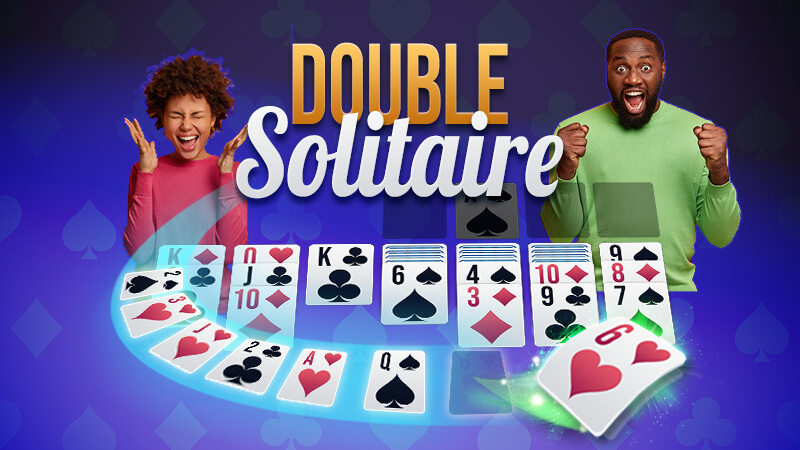Table of Contents
In this guide, we’ll walk you through the setup, rules, and strategies for playing Double Solitaire.
1. Double Solitaire Setup
You will need two standard decks of 52 playing cards, for a total of 104 cards.
Each player takes the deck they’ve been assigned (one of the two standard decks). From their deck, they deal the following layout:
- Create seven columns of cards.
- Each column starts with one card face up, and the remaining cards are dealt face down.
- The first column contains one card, the second column has two cards, and so on, until the seventh column, which contains seven cards.
In the central area, between the players’ layouts, lies room for foundation piles – four for each player.
Place the remaining deck (also known as the draw pile) face-down to the side of the foundation and tableau piles.
Players can opt for a turn-based approach, where each takes their moves consecutively, or they can engage in an exhilarating race, with everyone simultaneously striving to complete their unique solitaire journey.
2. Gameplay
Foundation Piles: Players can draw cards from their stockpile one at a time and attempt to build their foundation piles by suit and in ascending order. For example, if you have an Ace of Hearts in your foundation pile, you can place the 2 of Hearts on top, then the 3 of Hearts, and so on, up to the King of Hearts.
Tableau: Players can also move cards within their tableau (the row of face-up cards in front of them) or between their tableau and their foundation piles. Cards can be moved from one tableau column to another if the card you are moving is one rank lower and of the opposite color (e.g., a black 7 can be placed on a red 8).
Empty Spots: If you have an empty spot in your tableau, you can fill it with any available card.
Drawing Cards: Players can draw cards from their stockpile and place them in their tableau or foundation piles if they can be legally played.
The first player to successfully build their foundation piles up to King in ascending order by suit wins the game.
3. Taking Turns
In the turn-based version of the game, the player with the lower card on their one-pile initiates the game. In the event of a tie, the player with the lower card on their two-pile takes the lead, and so on.
During your turn, you have the liberty to execute a sequence of moves akin to those in Klondike. You can manipulate the cards on your layout, transfer suitable cards onto the foundation piles, and relocate cards from your discard pile to either your layout or the foundations.
However, it’s crucial to note that you are not allowed to interact with or employ your opponent’s layout or discard pile. Your turn concludes when you reach a point where you can no longer make any valid moves or choose not to do so, at which time you turn over the top card of your face-down stack and place it on your face-up discard pile. Subsequently, your opponent takes their turn.
4. Simultaneous Play
This dynamic version of the game can accommodate a range of players, from two to as many as six, seven, or beyond, each commencing with their 52-card deck. In this variant, players carry out moves following the same rules as mentioned above, with a notable exception: there are no designated turns. All players engage in rapid, simultaneous gameplay, utilizing only one hand.
Should you find yourself unable or unwilling to continue making moves with your face-up cards, you must flip over the top three cards from your stack and place them face-up on your discard pile, then resume your play. If your stack is depleted, you can flip your entire discard pile to create a fresh stack, unveiling the top three cards to initiate a new discard pile.


